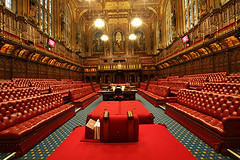
Lords reform is well and truly on the agenda. So much so that it seems plausible to say that it could split the coalition. Compromise seems desirable. But tensions between and within parties could see progress grind to a halt, a situation unwanted not least because all of the three major parties have actually expressed support for reform, at least in principle. In this context, here, I outline a proposal I developed in a recent paper that has, to my knowledge, not be aired in the Lords reform debate before.
I propose a reform that would reconstitute the House of ‘Lords’ with features that are commonly deemed desirable, but sometimes thought to be in conflict. Those features are that it should be:
- directly elected;
- representative (which implies electoral proportionality);
- a deliberative body in which contributions are made by people of experience, expertise, and specialist knowledge;
- subordinate to the House of Commons, both de jure and de facto.
In short, I propose that abstentions count as ‘votes’ for an Appointments Commission list. Read on to see why and how this would work.
How Does It Work?
At its core, the idea is that a statutory and independent commission creates a list of ‘expert’ legislators, and that this list receives a (share of a) vote for every abstention. The logic is to create a House that has a body of ‘experts’, but whilst doing so in a democratically-connected way.
More specifically, the chamber would be directly elected by a form of proportional representation. This would give (existing and new) parties an important role in candidate selection, albeit with the specifics of this depending on the electoral system put in place.*
In addition, an independent Appointments Commission would operate by creating a list of ‘experts’ much as it already does. The difference would be that the share of seats allocated to the Commission’s list would be democratically determined.
First, as the list would be published before the election, it would be open to the electorate to vote for it directly. To be clear, the performance of the Commission should not be evaluated on its share of the vote; only on its fulfillment of a mandate to produce a list of would-be legislators with expertise and experience that would be of value to the second chamber.
The second feature of the treatment of the Commission’s list is the more novel. Abstentions by voters would be treated as implicit votes for it. In this way, turnout becomes a key determinant of the composition of the second chamber. It remains an open question as to whether these ‘abstention votes’ should be weighted equally with ‘positive votes’, or whether they should count for less.
Some Examples
Ok, what sort of outcomes can we expect from such a reform? It is, obviously, difficult to predict how people would vote under this sort of system. However, I present two examples, below, that provide plausible illustrations of the composition of the new chamber. (I have also prepared a downloadable spreadsheet that allows for experiments with a whole range of assumptions.)
The first example takes the 2010 General Election result as a base line. Party vote shares are set to those for the 2010 result, as is turnout, and ‘abstention votes’ are weighted as the same as normal votes. The result looks like this.
| Party | Con | Lab | LD | Others | Commission |
|---|---|---|---|---|---|
| Vote share | 36 | 29 | 23 | 12 | 0 |
| Seat share | 23 | 19 | 15 | 8 | 35 |
While the previous example is based on observed election results, there are reasons to think that voting patterns may not be the same for a second chamber – especially if a more proportional system is used as smaller parties are likely to do better. The second example tries to take this into account. I allow the ‘Others’ share to rise at the expense of the three main parties. I also allow for ‘positive’ votes for the Commission list, which seems natural given the apparent importance people put on the presence of ‘experts’ in the second chamber. Finally, I also adjust the ‘abstention vote’ weight down so that they count for only one third of normal votes. The result looks like this.
| Party | Con | Lab | LD | Others | Commission |
|---|---|---|---|---|---|
| Vote share | 25 | 25 | 10 | 25 | 15 |
| Seat share | 21 | 21 | 9 | 21 | 28 |
These two examples provide fairly similar outcomes. Obviously, other results are possible, but one feature of this scheme is that, for reasonable turnout assumptions, it is rather difficult for even the two largest parties to form a majority by themselves. The ‘expert’ bloc forms an extremely important component of the chamber in most cases, unless the ‘abstention vote’ weight is rather small.
Would it work?
The examples above demonstrate how it could. I believe that they also show that a second chamber elected in the way described above can broadly be seen to exhibit each of the desirable properties enumerated above. Proportionality of the (positively) elected portion of the chamber provides representativeness as well as the direct democratic connection.
Most importantly, the presence of ‘expert’ legislators is all but guaranteed – subject to turnout being less than 100%. This helps to ensure that the final two desirable properties of a reformed chamber are achieved. On the one hand, the presence of ‘expert’ legislators should foster practice of some of the deliberative democratic ideals that both the general public and more scholarly contributors deem to be of value. On the other hand, the presence of legislators in the chamber who have not received ‘positive’ votes provides a check on the popular democratic legitimacy of the reformed body. As such, it helps to ensure the de facto supremacy of the House of Commons.
Of course, these advantages of having ‘expert’ legislators in the second chamber could be achieved by simply having a fixed proportion – say 20% – of members appointed. However, ‘abstention voting’ has some advantages over the fixed percentage approach. First, tying the share of ‘expert’ members to election outcomes has the appealing feature of making the composition of the chamber more responsive to the wishes of the electorate.
Second, the degree of de facto subordination of the second chamber to the House of Commons is at least partly a function of electoral turnout. That is, if voters become more engaged with the second chamber and therefore turn out to vote for it in higher numbers, then it seems likely that the chamber will become more assertive in the face of the Commons. This seems desirable as the chamber will be representing a larger proportion of the population. There is a similarity here with turnout requirements for referendums – where higher turnout is often seen to create both de jure and de facto legitimacy for their results.
Third, under a fixed proportion of ‘expert’ members, parties are engaged in zero sum competition for votes, whilst under ‘abstention voting’ they are engaged in positive sum competition. Thus, the proposal maintains an incentive for all parties to campaign to raise turnout as doing so increases the total proportion of seats that are available for them to win.
Fourth, and perhaps more speculatively, it seems plausible that such a reform would be politically palatable to a larger share of parliamentarians than existing proposals. It could represent a compromise between those wishing to create a strong democratic mandate for the second chamber, those wishing to ensure Commons supremacy, and those wishing to maintain a deliberative and ‘expert’-influenced revising and scrutinising legislative body.
Finally, it may be argued that avoiding ‘abstention voting’ and simply having a Commission list available for people to vote for would be sufficient. Doing so would avoid the undue privileging of ‘experts’ in a democratic sense. However, I suggest that there are perils with this route. Most simply, by not counting abstentions, such a scheme does not build in a tendency towards the de facto supremacy of the Commons. However, there are other difficulties. Would the Commission (or those on its list) actively campaign in elections? Against other parties? If not, it would be disadvantaged in electoral terms by a lack publicity and information reaching the electorate, with the implication being an under-supply of ‘experts’ in the chamber. On the other hand, a Commission that did engage in campaigning would seem be taking a very dangerous road. Doing so would blur the line between the Commission as an independent statutory body and the Commission as political party. Political-cum-constitutional controversy would seem perilously likely in this situation. More pragmatically, it is not difficult to imagine that a campaigning requirement would put off potential legislators with valuable expertise but who are not enamoured of stump speeches and the like. Part of the value of the present chamber is that many of its members are the sort of people who have shunned the rigours of the campaign trail in favour of other careers.
Tim Hicks is an Ussher Assistant Professor of Political Economy at Trinity College, Dublin. He received a DPhil in Politics at Nuffield College, Oxford, in 2009. His web site is at http://tim.hicks.me.uk/ and he can be reached by email at tim.hicks@tcd.ie.







2 Comments